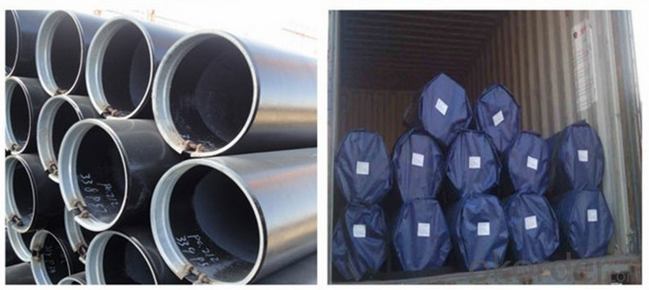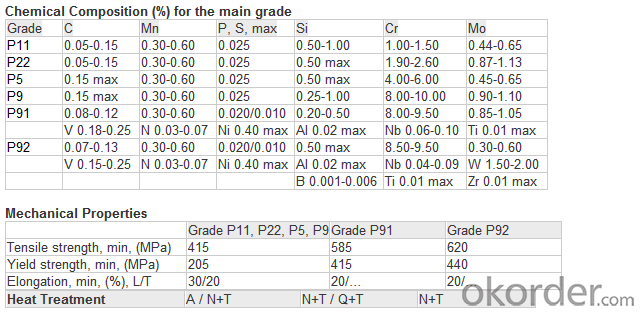P22 Seamless Ferritic Alloy-Steel Pipe for High-Temperature
- Loading Port:
- Shanghai
- Payment Terms:
- TT OR LC
- Min Order Qty:
- 1000 kg
- Supply Capability:
- 10000 kg/month
OKorder Service Pledge
OKorder Financial Service
You Might Also Like
Product particular communication:
1) Size: OD > 6.35 mm & Thk > 0.89 mm ;
2) Tight tolerance, Smooth surface, Uniform mechanical property(Mechanical Properties equilibrium) ;
3) Heat treatment: BK, BKS, GBK, NBK,Stress Relief, Normalizing, Spheroidize Anneal, Annealing, Bright Annealing, Normalized, Quenched and Tempered, Solution Annealing, etc ;
4) Continuous stenciling as required ;
5) Rust prevention treatment, such as: immersion oil, lacquer, passivation, phosphating,etc;
6) Plastic plugs or caps on both ends as required ;
7) Packaging: Hexagonal bundles of max. 1,500kg with several steel strips, Wrapped in waterproof paper, PVC sleeve,and sackcloth with several steel strips or packed in heavy tri-wall boxes, wooden boxes, wooden slats as requires;Type: Round , Square, Rectangle, Hexagon. Streamline, etc;
ASTM A335 Seamless Alloy-Steel Pipe
Standard: BS 1139, BS 3059-2, JIS G3454-2007
Grade: 10#-45#, 15NiCuMoNb5, 10Cr9Mo1VNb
Detailed introduction to ASTM A335 seamless alloy steel pipe:
ASTM A335 seamless alloy steel pipe


FAQ:
1) why you chose us ?
Professional Manufacturer and supplier of Steel pipe
More than 14 years’ professional producing experience
We can get the lowest ex-factory prices. The price are quite reasonable and it is lower than our commercial peers. also, we can guarantee the qualities of our products.
BV, ISO certificates and SGS test can be provided to assure the quality of our products.
2) Our minimum order quantity:
10 Metric Tons or one 20ft or 40ft Container.
3) How about the Delivery Time?
The steel pipe will be produced since we getting your deposit by T/T or Your original L/C. For normal size, some stocks in our factory now, we can supply once you need.
4)What kind of payment does your company support?
T/T, 100% L/C at sight, Cash, Western Union are all accepted.
5) Do you charge for the samples?
According to our company principle, we just charge for samples, you pay for the freight /courier charge.
6) Main market:
Mid East, South America, Africa, Southeast Asia, India etc
- Q:Can stainless steel pipes be mirror polished?
- Yes, stainless steel pipes can be mirror polished. Mirror polishing is a process that involves grinding down the surface of the stainless steel pipe until it is smooth and then using a series of polishing compounds to achieve a high gloss finish. This process can be done by hand or with the use of specialized machinery. The mirror polished finish not only enhances the aesthetic appeal of the stainless steel pipe but also provides added protection against corrosion and staining. However, it is important to note that the mirror polished finish may require regular maintenance to maintain its shine over time.
- Q:How do stainless steel pipes compare to polypropylene pipes?
- Stainless steel pipes and polypropylene pipes are both popular options for various plumbing and industrial uses, but they have distinct qualities that set them apart. To begin with, stainless steel pipes are renowned for their exceptional durability and strength, allowing them to withstand high pressure and temperature conditions. This makes them suitable for applications that require robustness and reliability. Conversely, polypropylene pipes may not be as strong as stainless steel and may not be suitable for high-pressure environments. Moreover, stainless steel pipes possess excellent corrosion resistance properties, making them highly resistant to rust, corrosion, and chemical reactions. This makes them ideal for plumbing systems that handle corrosive fluids or gases. In contrast, polypropylene pipes, although resistant to many chemicals, may not offer the same level of corrosion resistance as stainless steel pipes. Furthermore, stainless steel pipes provide excellent hygiene and cleanliness due to their smooth interior surface, which discourages the growth of bacteria and biofilm. This makes them suitable for industries such as food and beverage or medical facilities. On the other hand, polypropylene pipes, while relatively resistant to bacterial growth, may not provide the same level of cleanliness as stainless steel. Additionally, stainless steel pipes are known for their longevity and low maintenance requirements. They have a longer lifespan compared to polypropylene pipes, which may need to be replaced more frequently. Stainless steel pipes also require less maintenance and are less prone to leaks or cracks. However, it is important to note that polypropylene pipes have their own advantages. They are lightweight, easy to install, and relatively cost-effective compared to stainless steel pipes. Polypropylene also possesses excellent thermal insulation properties, which can be beneficial in certain applications. Ultimately, the choice between stainless steel pipes and polypropylene pipes depends on the specific requirements of the project. Factors such as pressure, temperature, corrosion resistance, cleanliness, and budget should be taken into consideration to determine the most suitable option. Seeking advice from a professional plumber or engineer can assist in making an informed decision.
- Q:Can stainless steel pipes be laser welded?
- Yes, stainless steel pipes can be laser welded. Laser welding is a highly efficient and precise method of joining metals, including stainless steel. It involves the use of a high-powered laser beam to melt and fuse the edges of the pipes together. Laser welding is commonly used in various industries, such as automotive, aerospace, and construction, due to its ability to create strong and durable welds with minimal distortion. The process is particularly well-suited for stainless steel, as it offers excellent control over the heat input, resulting in a narrow and well-defined weld zone. Additionally, laser welding can be automated, making it a cost-effective and time-efficient solution for joining stainless steel pipes.
- Q:What is the difference between 316 and 316L stainless steel pipes?
- The main difference between 316 and 316L stainless steel pipes is the carbon content. 316L has a lower carbon content, making it more resistant to corrosion and suitable for applications where welding is required. It also has a higher creep, stress-to-rupture, and tensile strength, making it a preferred choice in high-temperature environments.
- Q:Are stainless steel pipes suitable for geothermal applications?
- Yes, stainless steel pipes are suitable for geothermal applications. Stainless steel is highly resistant to corrosion and can withstand the high temperatures and pressures present in geothermal systems. Additionally, stainless steel pipes have excellent thermal conductivity, making them efficient for transferring heat in geothermal applications.
- Q:What is the difference between ERW and EFW stainless steel pipes?
- ERW (Electric Resistance Welded) stainless steel pipes are manufactured by rolling a flat steel into a cylindrical shape and then welding the edges together using electric resistance heat. On the other hand, EFW (Electric Fusion Welded) stainless steel pipes are produced by melting the edges of two steel plates or strips and then welding them together using an electric current. The main difference between ERW and EFW stainless steel pipes lies in the welding process, with ERW pipes having a smoother internal surface due to the absence of filler material, while EFW pipes have a slightly thicker weld seam. Additionally, EFW pipes are generally used for larger diameters and thicker walls, whereas ERW pipes are commonly used for smaller diameters and thinner walls.
- Q:Can stainless steel pipes be used for chemical storage tanks?
- Indeed, stainless steel pipes have the capability to serve as chemical storage tanks. Renowned for its exceptional resistance to corrosion, stainless steel proves to be an optimal substance for the containment of chemicals. An extensive array of chemicals, such as acids, alkalis, solvents, and gases, face no challenge in penetrating its defenses. Furthermore, stainless steel boasts durability and strength, guaranteeing the structural integrity of the storage tanks. Moreover, its effortless cleaning and maintenance render it suitable for housing various types of chemicals. Nevertheless, one must exercise caution and thoroughly consider the specific properties and demands of the chemicals before opting for stainless steel pipes as chemical storage tanks.
- Q:What is the difference between seamless and longitudinal welded stainless steel pipes?
- Seamless and longitudinal welded stainless steel pipes differ primarily in their manufacturing processes and structural characteristics. Seamless stainless steel pipes are created by piercing a solid cylindrical bar of stainless steel to form a hollow tube. This process involves heating the bar and then pushing it through a die to shape the desired size and dimensions. The resulting pipe has no welded seams, hence the name "seamless". This manufacturing method ensures a uniform and consistent composition throughout the pipe, offering excellent strength and corrosion resistance. Seamless pipes are generally considered to have superior mechanical properties and are often used in high-pressure applications, such as oil and gas pipelines or refinery equipment. On the other hand, longitudinal welded stainless steel pipes are made by joining two separate pieces of stainless steel plate or sheet through a longitudinal welding process. This involves rolling the plates or sheets into a cylindrical shape and welding the seam along the length of the pipe. The longitudinal weld provides structural integrity and strength to the pipe. Although the weld may introduce some inconsistencies in the composition and properties of the steel, it can be minimized through proper welding techniques and quality control measures. Longitudinal welded pipes are commonly used in a wide range of applications, including structural and architectural projects, as well as in industries such as food processing, pharmaceuticals, and petrochemicals. In summary, the main difference between seamless and longitudinal welded stainless steel pipes lies in their manufacturing methods and resulting structural characteristics. Seamless pipes have no welded seams and offer excellent mechanical properties, making them suitable for high-pressure applications. Longitudinal welded pipes, on the other hand, are created by welding two separate pieces of stainless steel and are commonly used in a variety of industries. Both types of pipes have their advantages and are selected based on specific requirements and considerations of the intended application.
- Q:Can stainless steel pipes be insulated with mineral wool?
- Yes, stainless steel pipes can indeed be insulated with mineral wool. Mineral wool is a common and effective insulation material used in various industries, including plumbing and construction. It is capable of withstanding high temperatures and offers excellent thermal and acoustic insulation properties. Additionally, mineral wool is non-combustible and resistant to moisture, making it suitable for insulating stainless steel pipes that carry hot or cold fluids. The insulation can help prevent heat loss, reduce energy consumption, and protect against condensation and pipe sweating.
- Q:How do stainless steel pipes compare to polyethylene pipes?
- Stainless steel pipes have higher durability and strength compared to polyethylene pipes. They are resistant to corrosion, heat, and pressure, making them suitable for diverse applications in industries such as oil and gas, construction, and water treatment. On the other hand, polyethylene pipes are more flexible, lightweight, and cost-effective, making them ideal for underground water and gas distribution systems. The choice between stainless steel and polyethylene pipes depends on factors like the specific application, budget, and environmental conditions.
1. Manufacturer Overview |
|
|---|---|
| Location | |
| Year Established | |
| Annual Output Value | |
| Main Markets | |
| Company Certifications | |
2. Manufacturer Certificates |
|
|---|---|
| a) Certification Name | |
| Range | |
| Reference | |
| Validity Period | |
3. Manufacturer Capability |
|
|---|---|
| a)Trade Capacity | |
| Nearest Port | |
| Export Percentage | |
| No.of Employees in Trade Department | |
| Language Spoken: | |
| b)Factory Information | |
| Factory Size: | |
| No. of Production Lines | |
| Contract Manufacturing | |
| Product Price Range | |
Send your message to us
P22 Seamless Ferritic Alloy-Steel Pipe for High-Temperature
- Loading Port:
- Shanghai
- Payment Terms:
- TT OR LC
- Min Order Qty:
- 1000 kg
- Supply Capability:
- 10000 kg/month
OKorder Service Pledge
OKorder Financial Service
Similar products
New products
Hot products
Hot Searches
Related keywords




























